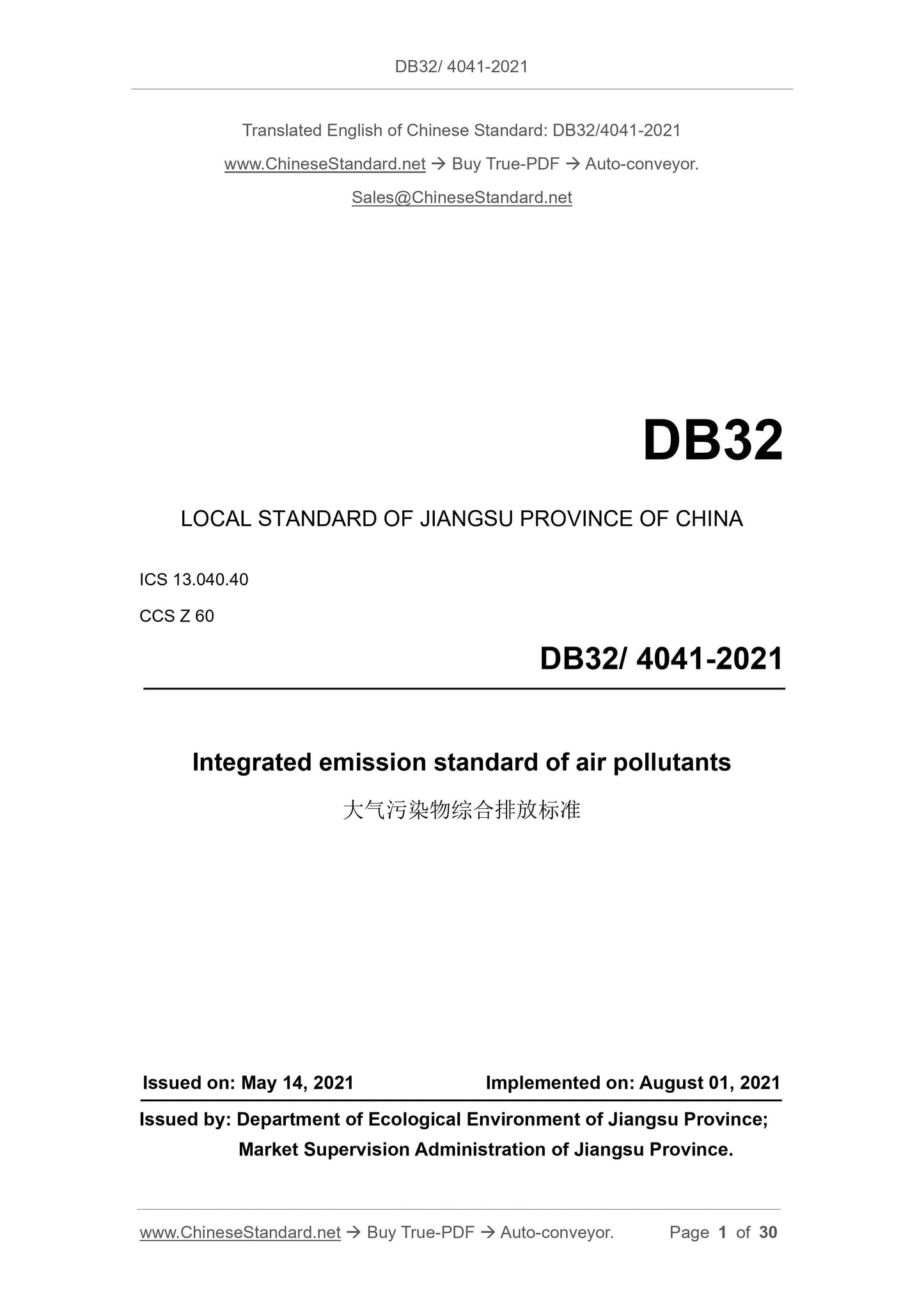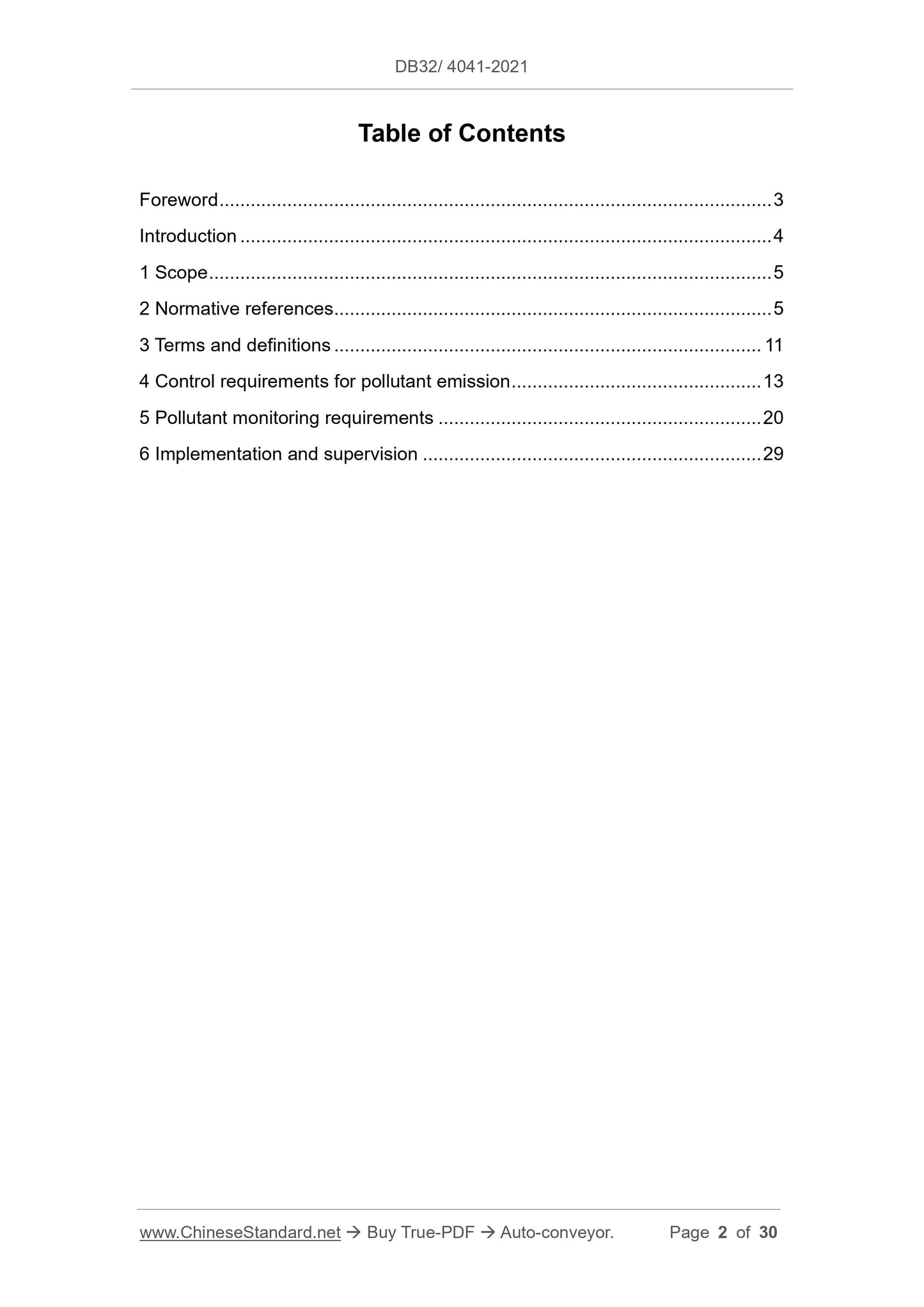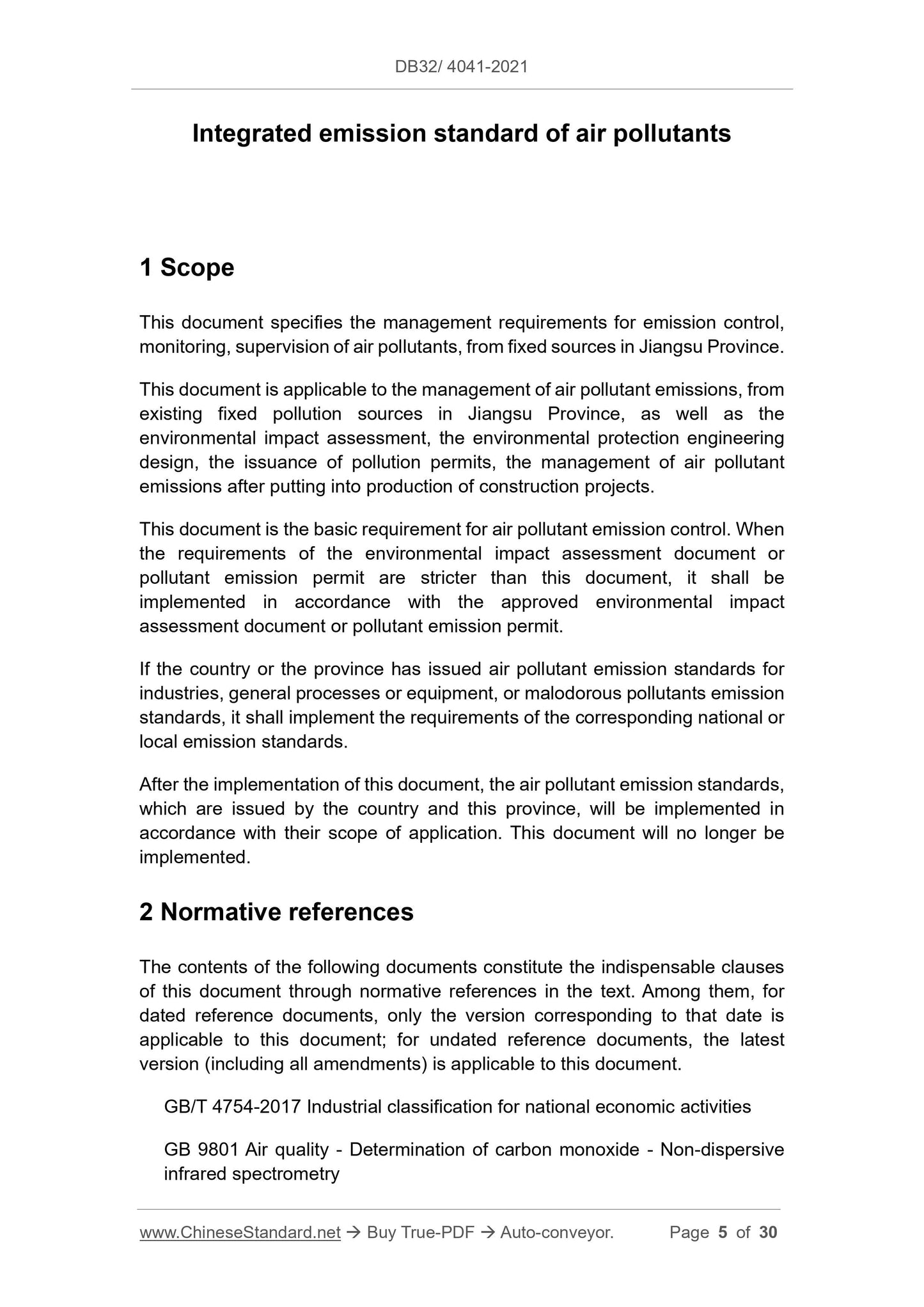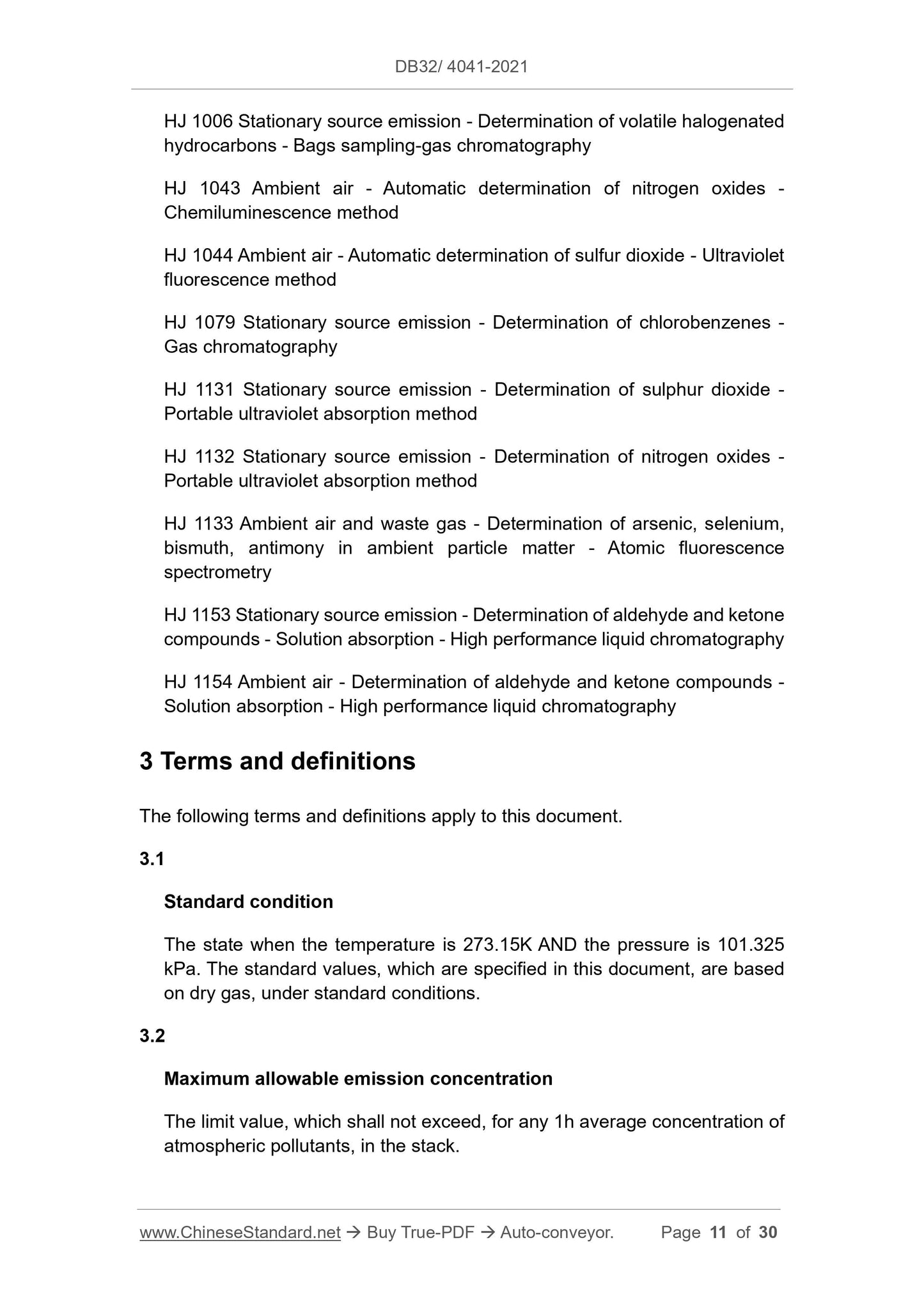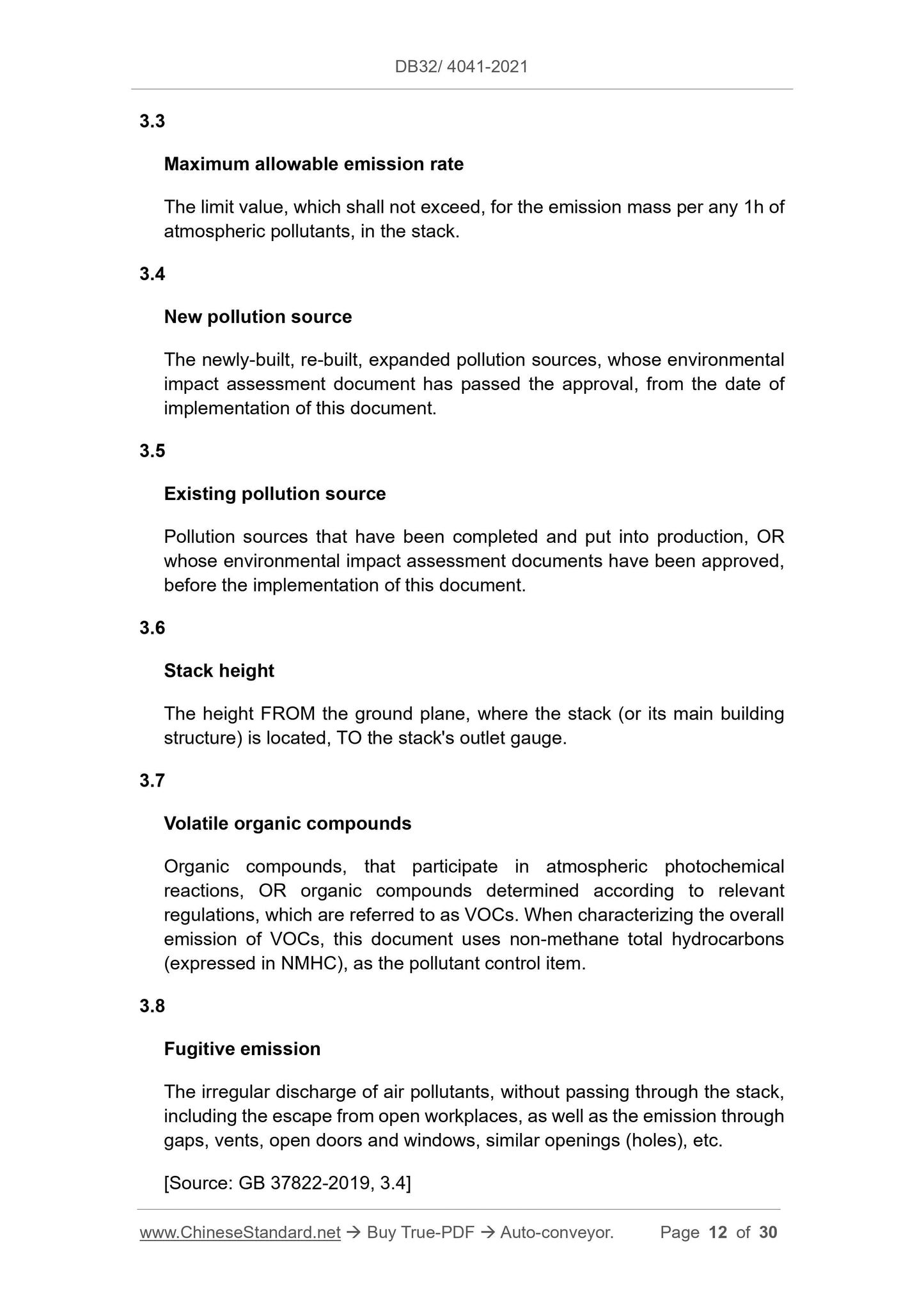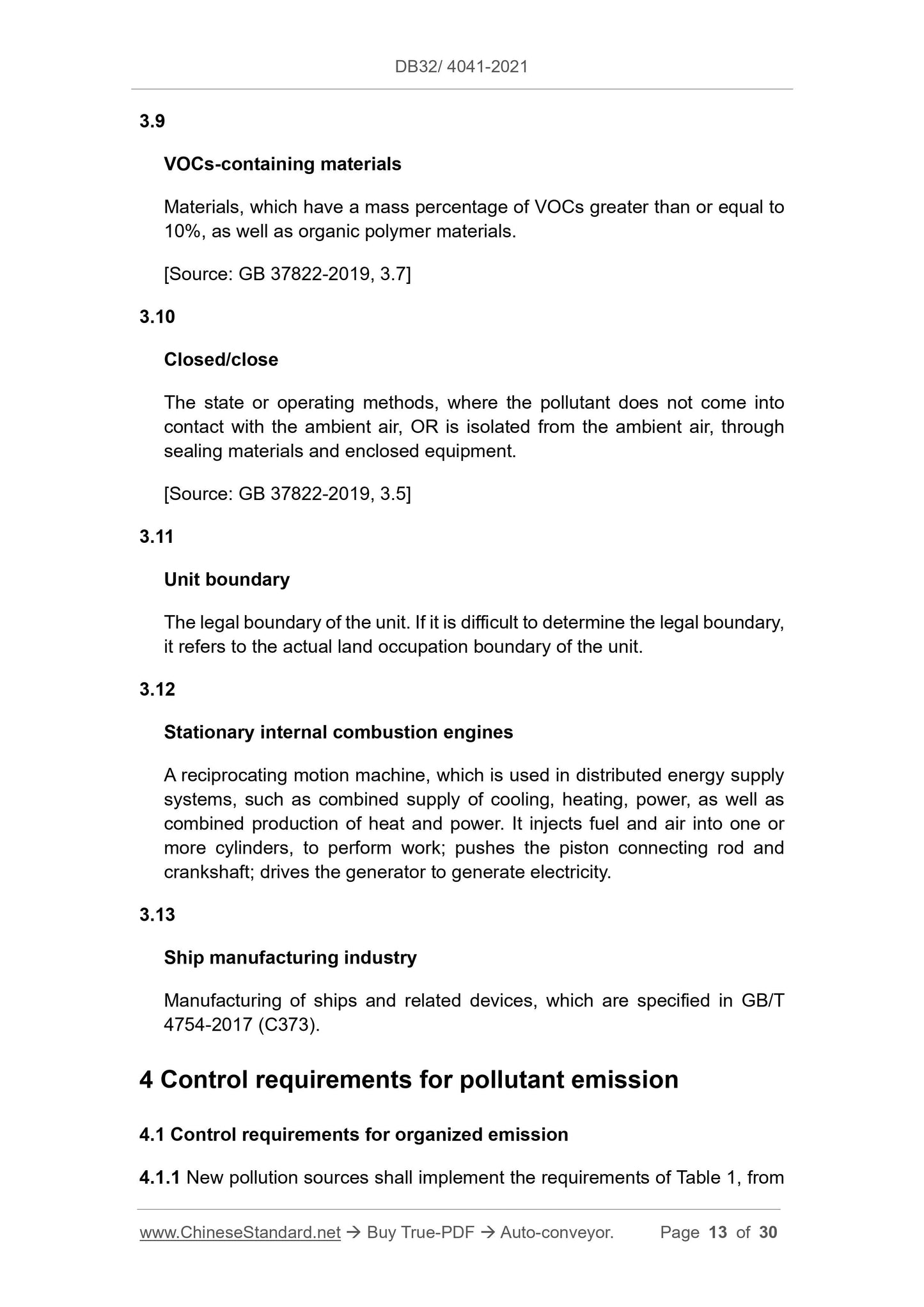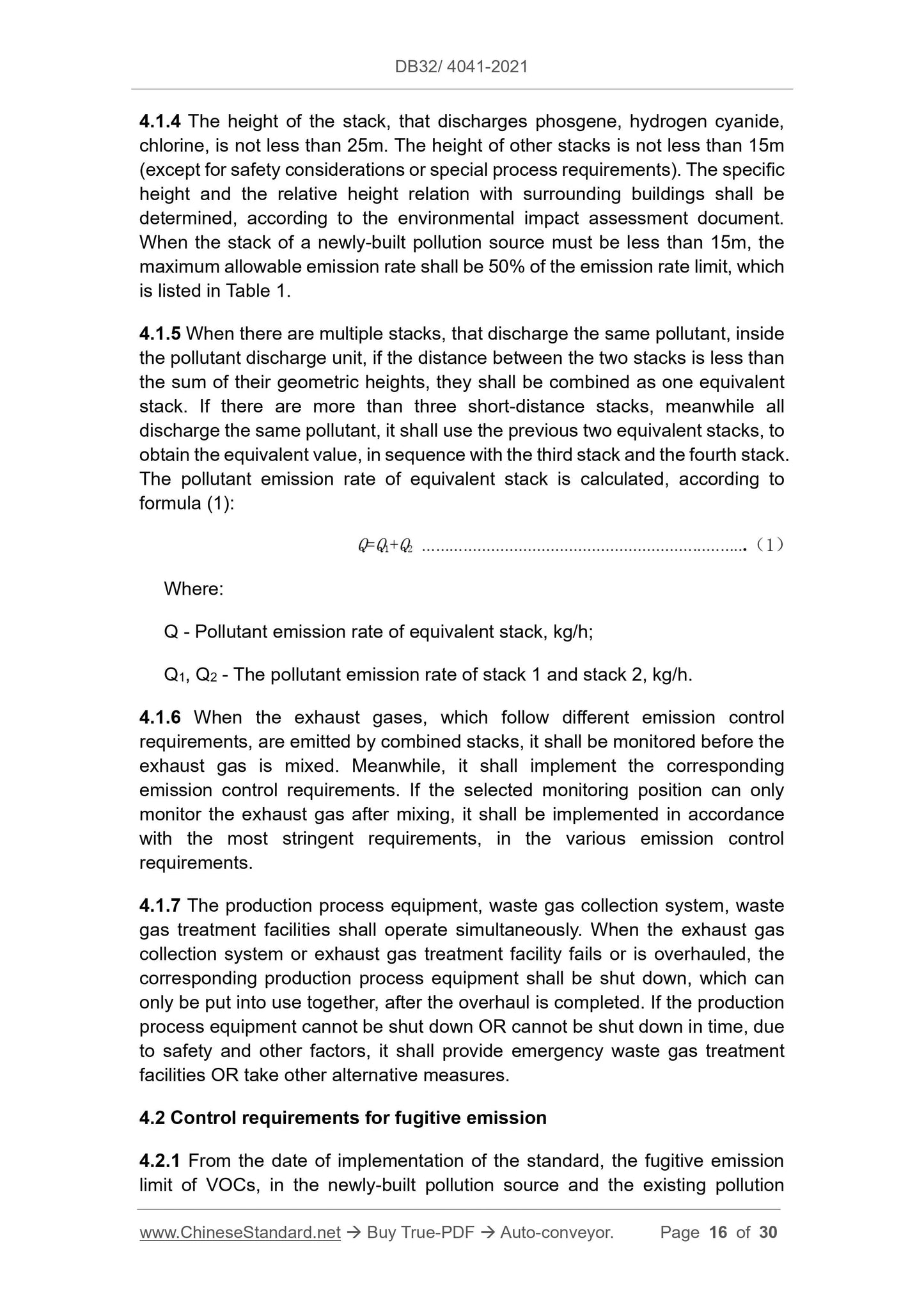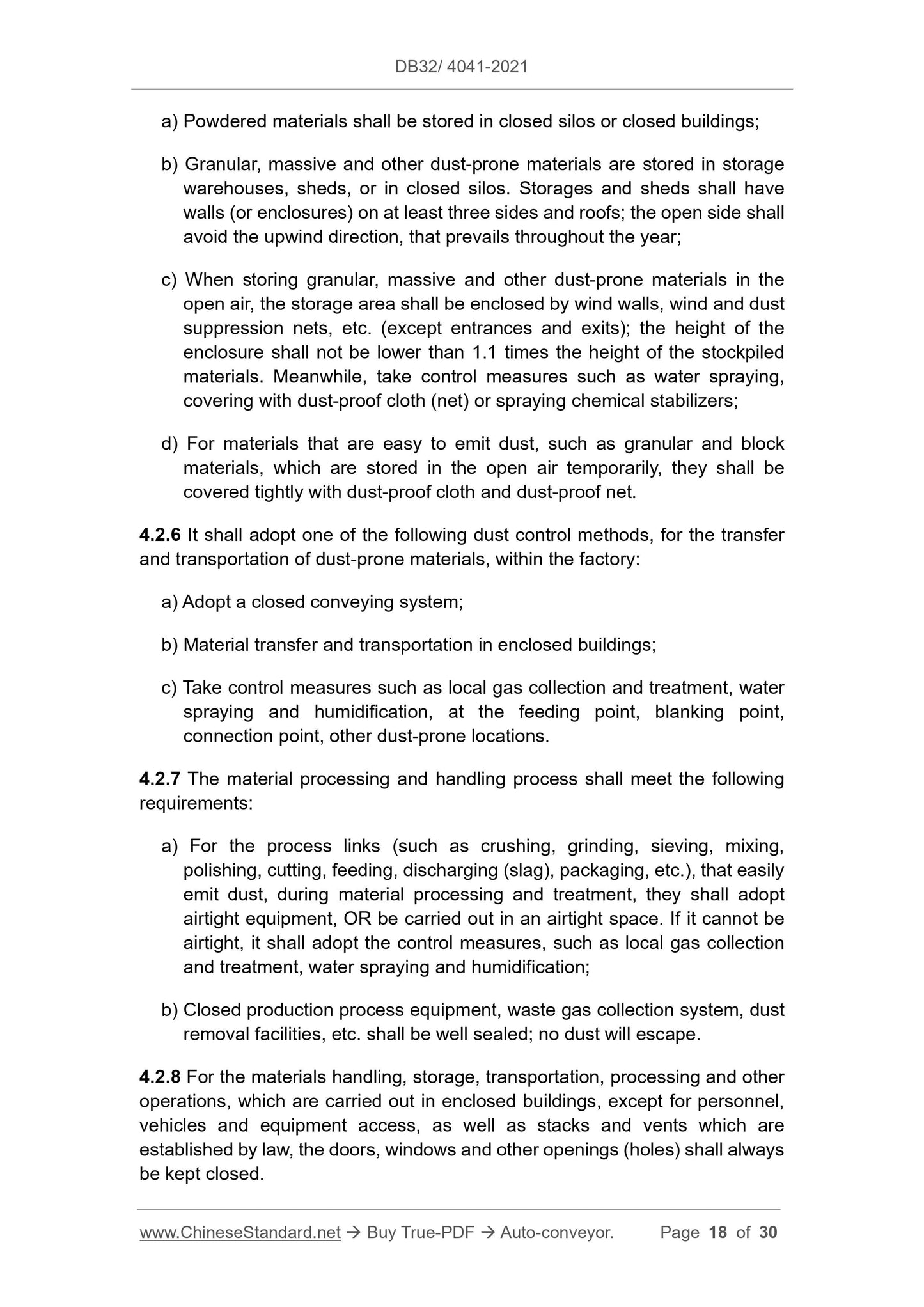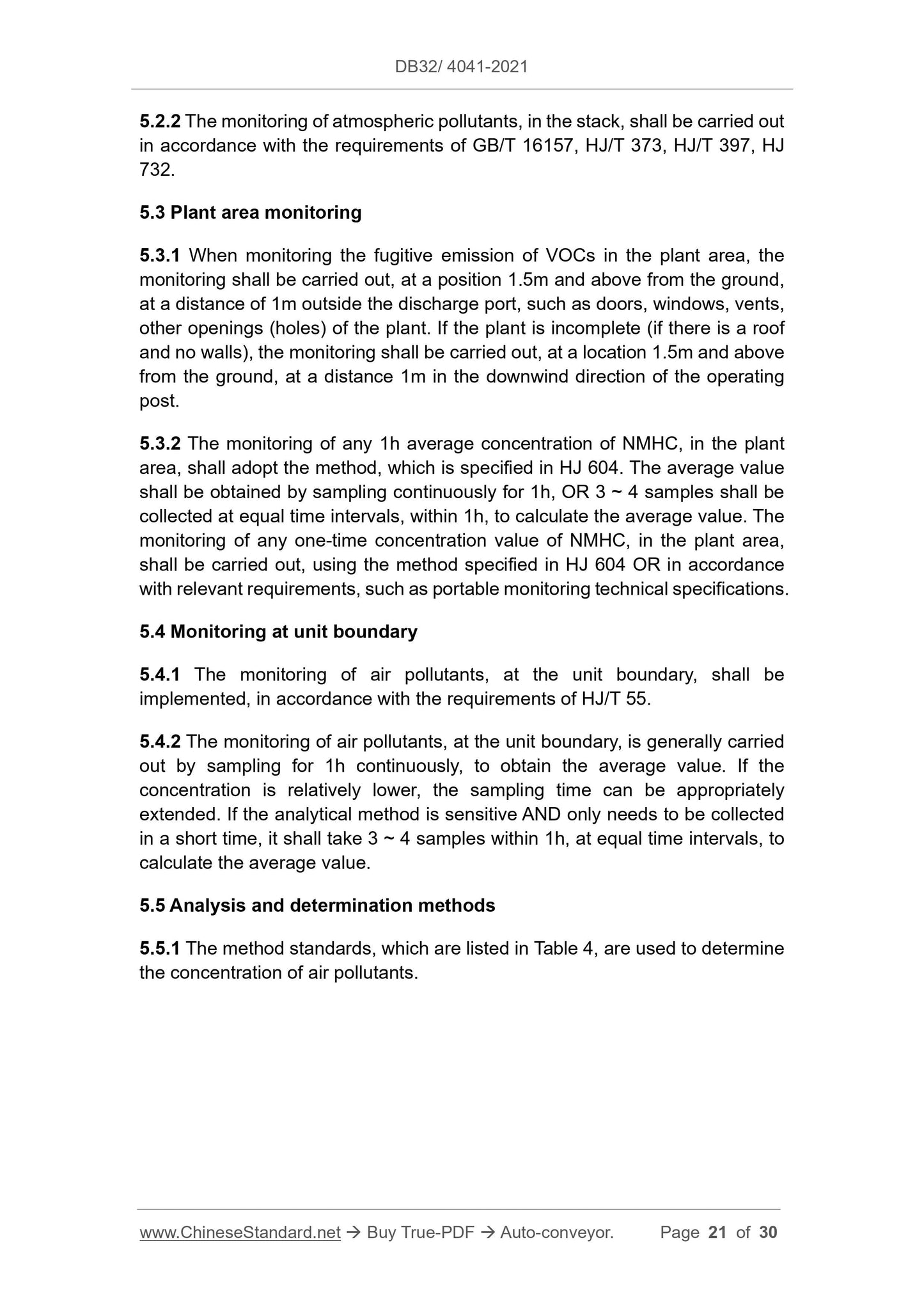1
/
su
9
PayPal, credit cards. Download editable-PDF and invoice in 1 second!
DB32/ 4041-2021 English PDF (DB324041-2021)
DB32/ 4041-2021 English PDF (DB324041-2021)
Prezzo di listino
$405.00 USD
Prezzo di listino
Prezzo scontato
$405.00 USD
Prezzo unitario
/
per
Spese di spedizione calcolate al check-out.
Impossibile caricare la disponibilità di ritiro
Delivery: 3 seconds. Download true-PDF + Invoice.
Get QUOTATION in 1-minute: Click DB32/ 4041-2021
Historical versions: DB32/ 4041-2021
Preview True-PDF (Reload/Scroll if blank)
DB32/ 4041-2021: Integrated emission standard of air pollutants
DB32/ 4041-2021
DB32
LOCAL STANDARD OF JIANGSU PROVINCE OF CHINA
ICS 13.040.40
CCS Z 60
Integrated emission standard of air pollutants
ISSUED ON: MAY 14, 2021
IMPLEMENTED ON: AUGUST 01, 2021
Issued by: Department of Ecological Environment of Jiangsu Province;
Market Supervision Administration of Jiangsu Province.
Table of Contents
Foreword ... 3
Introduction ... 4
1 Scope ... 5
2 Normative references ... 5
3 Terms and definitions ... 11
4 Control requirements for pollutant emission ... 13
5 Pollutant monitoring requirements ... 20
6 Implementation and supervision ... 29
Integrated emission standard of air pollutants
1 Scope
This document specifies the management requirements for emission control,
monitoring, supervision of air pollutants, from fixed sources in Jiangsu Province.
This document is applicable to the management of air pollutant emissions, from
existing fixed pollution sources in Jiangsu Province, as well as the
environmental impact assessment, the environmental protection engineering
design, the issuance of pollution permits, the management of air pollutant
emissions after putting into production of construction projects.
This document is the basic requirement for air pollutant emission control. When
the requirements of the environmental impact assessment document or
pollutant emission permit are stricter than this document, it shall be
implemented in accordance with the approved environmental impact
assessment document or pollutant emission permit.
If the country or the province has issued air pollutant emission standards for
industries, general processes or equipment, or malodorous pollutants emission
standards, it shall implement the requirements of the corresponding national or
local emission standards.
After the implementation of this document, the air pollutant emission standards,
which are issued by the country and this province, will be implemented in
accordance with their scope of application. This document will no longer be
implemented.
2 Normative references
The contents of the following documents constitute the indispensable clauses
of this document through normative references in the text. Among them, for
dated reference documents, only the version corresponding to that date is
applicable to this document; for undated reference documents, the latest
version (including all amendments) is applicable to this document.
GB/T 4754-2017 Industrial classification for national economic activities
GB 9801 Air quality - Determination of carbon monoxide - Non-dispersive
infrared spectrometry
HJ 1006 Stationary source emission - Determination of volatile halogenated
hydrocarbons - Bags sampling-gas chromatography
HJ 1043 Ambient air - Automatic determination of nitrogen oxides -
Chemiluminescence method
HJ 1044 Ambient air - Automatic determination of sulfur dioxide - Ultraviolet
fluorescence method
HJ 1079 Stationary source emission - Determination of chlorobenzenes -
Gas chromatography
HJ 1131 Stationary source emission - Determination of sulphur dioxide -
Portable ultraviolet absorption method
HJ 1132 Stationary source emission - Determination of nitrogen oxides -
Portable ultraviolet absorption method
HJ 1133 Ambient air and waste gas - Determination of arsenic, selenium,
bismuth, antimony in ambient particle matter - Atomic fluorescence
spectrometry
HJ 1153 Stationary source emission - Determination of aldehyde and ketone
compounds - Solution absorption - High performance liquid chromatography
HJ 1154 Ambient air - Determination of aldehyde and ketone compounds -
Solution absorption - High performance liquid chromatography
3 Terms and definitions
The following terms and definitions apply to this document.
3.1
Standard condition
The state when the temperature is 273.15K AND the pressure is 101.325
kPa. The standard values, which are specified in this document, are based
on dry gas, under standard conditions.
3.2
Maximum allowable emission concentration
The limit value, which shall not exceed, for any 1h average concentration of
atmospheric pollutants, in the stack.
3.3
Maximum allowable emission rate
The limit value, which shall not exceed, for the emission mass per any 1h of
atmospheric pollutants, in the stack.
3.4
New pollution source
The newly-built, re-built, expanded pollution sources, whose environmental
impact assessment document has passed the approval, from the date of
implementation of this document.
3.5
Existing pollution source
Pollution sources that have been completed and put into production, OR
whose environmental impact assessment documents have been approved,
before the implementation of this document.
3.6
Stack height
The height FROM the ground plane, where the stack (or its main building
structure) is located, TO the stack's outlet gauge.
3.7
Volatile organic compounds
Organic compounds, that participate in atmospheric photochemical
reactions, OR organic compounds determined according to relevant
regulations, which are referred to as VOCs. When characterizing the overall
emission of VOCs, this document uses non-methane total hydrocarbons
(expressed in NMHC), as the pollutant control item.
3.8
Fugitive emission
The irregular discharge of air pollutants, without passing through the stack,
including the escape from open workplaces, as well as the emission through
gaps, vents, open doors and windows, similar openings (holes), etc.
[Source: GB 37822-2019, 3.4]
3.9
VOCs-containing materials
Materials, which have a mass percentage of VOCs greater than or equal to
10%, as well as organic polymer materials.
[Source: GB 37822-2019, 3.7]
3.10
Closed/close
The state or operating methods, where the pollutant does not come into
contact with the ambient air, OR is isolated from the ambient air, through
sealing materials and enclosed equipment.
[Source: GB 37822-2019, 3.5]
3.11
Unit boundary
The legal boundary of the unit. If it is difficult to determine the legal boundary,
it refers to the actual land occupation boundary of the unit.
3.12
Stationary internal combustion engines
A reciprocating motion machine, which is used in distributed energy supply
systems, such as combined supply of cooling, heating, power, as well as
combined production of heat and power. It injects fuel and air into one or
more cylinders, to perform work; pushes the piston connecting rod and
crankshaft; drives the generator to generate electricity.
3.13
Ship manufacturing industry
Manufacturing of ships and related devices, which are specified in GB/T
4754-2017 (C373).
4 Control requirements for pollutant emission
4.1 Control requirements for organized emission
4.1.1 New pollution sources shall implement the requirements of Table 1, from
4.1.4 The height of the stack, that discharges phosgene, hydrogen cyanide,
chlorine, is not less than 25m. The height of other stacks is not less than 15m
(except for safety considerations or special process requirements). The specific
height and the relative height relation with surrounding buildings shall be
determined, according to the environmental impact assessment document.
When the stack of a newly-built pollution source must be less than 15m, the
maximum allowable emission rate shall be 50% of the emission rate limit, which
is listed in Table 1.
4.1.5 When there are multiple stacks...
Get QUOTATION in 1-minute: Click DB32/ 4041-2021
Historical versions: DB32/ 4041-2021
Preview True-PDF (Reload/Scroll if blank)
DB32/ 4041-2021: Integrated emission standard of air pollutants
DB32/ 4041-2021
DB32
LOCAL STANDARD OF JIANGSU PROVINCE OF CHINA
ICS 13.040.40
CCS Z 60
Integrated emission standard of air pollutants
ISSUED ON: MAY 14, 2021
IMPLEMENTED ON: AUGUST 01, 2021
Issued by: Department of Ecological Environment of Jiangsu Province;
Market Supervision Administration of Jiangsu Province.
Table of Contents
Foreword ... 3
Introduction ... 4
1 Scope ... 5
2 Normative references ... 5
3 Terms and definitions ... 11
4 Control requirements for pollutant emission ... 13
5 Pollutant monitoring requirements ... 20
6 Implementation and supervision ... 29
Integrated emission standard of air pollutants
1 Scope
This document specifies the management requirements for emission control,
monitoring, supervision of air pollutants, from fixed sources in Jiangsu Province.
This document is applicable to the management of air pollutant emissions, from
existing fixed pollution sources in Jiangsu Province, as well as the
environmental impact assessment, the environmental protection engineering
design, the issuance of pollution permits, the management of air pollutant
emissions after putting into production of construction projects.
This document is the basic requirement for air pollutant emission control. When
the requirements of the environmental impact assessment document or
pollutant emission permit are stricter than this document, it shall be
implemented in accordance with the approved environmental impact
assessment document or pollutant emission permit.
If the country or the province has issued air pollutant emission standards for
industries, general processes or equipment, or malodorous pollutants emission
standards, it shall implement the requirements of the corresponding national or
local emission standards.
After the implementation of this document, the air pollutant emission standards,
which are issued by the country and this province, will be implemented in
accordance with their scope of application. This document will no longer be
implemented.
2 Normative references
The contents of the following documents constitute the indispensable clauses
of this document through normative references in the text. Among them, for
dated reference documents, only the version corresponding to that date is
applicable to this document; for undated reference documents, the latest
version (including all amendments) is applicable to this document.
GB/T 4754-2017 Industrial classification for national economic activities
GB 9801 Air quality - Determination of carbon monoxide - Non-dispersive
infrared spectrometry
HJ 1006 Stationary source emission - Determination of volatile halogenated
hydrocarbons - Bags sampling-gas chromatography
HJ 1043 Ambient air - Automatic determination of nitrogen oxides -
Chemiluminescence method
HJ 1044 Ambient air - Automatic determination of sulfur dioxide - Ultraviolet
fluorescence method
HJ 1079 Stationary source emission - Determination of chlorobenzenes -
Gas chromatography
HJ 1131 Stationary source emission - Determination of sulphur dioxide -
Portable ultraviolet absorption method
HJ 1132 Stationary source emission - Determination of nitrogen oxides -
Portable ultraviolet absorption method
HJ 1133 Ambient air and waste gas - Determination of arsenic, selenium,
bismuth, antimony in ambient particle matter - Atomic fluorescence
spectrometry
HJ 1153 Stationary source emission - Determination of aldehyde and ketone
compounds - Solution absorption - High performance liquid chromatography
HJ 1154 Ambient air - Determination of aldehyde and ketone compounds -
Solution absorption - High performance liquid chromatography
3 Terms and definitions
The following terms and definitions apply to this document.
3.1
Standard condition
The state when the temperature is 273.15K AND the pressure is 101.325
kPa. The standard values, which are specified in this document, are based
on dry gas, under standard conditions.
3.2
Maximum allowable emission concentration
The limit value, which shall not exceed, for any 1h average concentration of
atmospheric pollutants, in the stack.
3.3
Maximum allowable emission rate
The limit value, which shall not exceed, for the emission mass per any 1h of
atmospheric pollutants, in the stack.
3.4
New pollution source
The newly-built, re-built, expanded pollution sources, whose environmental
impact assessment document has passed the approval, from the date of
implementation of this document.
3.5
Existing pollution source
Pollution sources that have been completed and put into production, OR
whose environmental impact assessment documents have been approved,
before the implementation of this document.
3.6
Stack height
The height FROM the ground plane, where the stack (or its main building
structure) is located, TO the stack's outlet gauge.
3.7
Volatile organic compounds
Organic compounds, that participate in atmospheric photochemical
reactions, OR organic compounds determined according to relevant
regulations, which are referred to as VOCs. When characterizing the overall
emission of VOCs, this document uses non-methane total hydrocarbons
(expressed in NMHC), as the pollutant control item.
3.8
Fugitive emission
The irregular discharge of air pollutants, without passing through the stack,
including the escape from open workplaces, as well as the emission through
gaps, vents, open doors and windows, similar openings (holes), etc.
[Source: GB 37822-2019, 3.4]
3.9
VOCs-containing materials
Materials, which have a mass percentage of VOCs greater than or equal to
10%, as well as organic polymer materials.
[Source: GB 37822-2019, 3.7]
3.10
Closed/close
The state or operating methods, where the pollutant does not come into
contact with the ambient air, OR is isolated from the ambient air, through
sealing materials and enclosed equipment.
[Source: GB 37822-2019, 3.5]
3.11
Unit boundary
The legal boundary of the unit. If it is difficult to determine the legal boundary,
it refers to the actual land occupation boundary of the unit.
3.12
Stationary internal combustion engines
A reciprocating motion machine, which is used in distributed energy supply
systems, such as combined supply of cooling, heating, power, as well as
combined production of heat and power. It injects fuel and air into one or
more cylinders, to perform work; pushes the piston connecting rod and
crankshaft; drives the generator to generate electricity.
3.13
Ship manufacturing industry
Manufacturing of ships and related devices, which are specified in GB/T
4754-2017 (C373).
4 Control requirements for pollutant emission
4.1 Control requirements for organized emission
4.1.1 New pollution sources shall implement the requirements of Table 1, from
4.1.4 The height of the stack, that discharges phosgene, hydrogen cyanide,
chlorine, is not less than 25m. The height of other stacks is not less than 15m
(except for safety considerations or special process requirements). The specific
height and the relative height relation with surrounding buildings shall be
determined, according to the environmental impact assessment document.
When the stack of a newly-built pollution source must be less than 15m, the
maximum allowable emission rate shall be 50% of the emission rate limit, which
is listed in Table 1.
4.1.5 When there are multiple stacks...
Share
